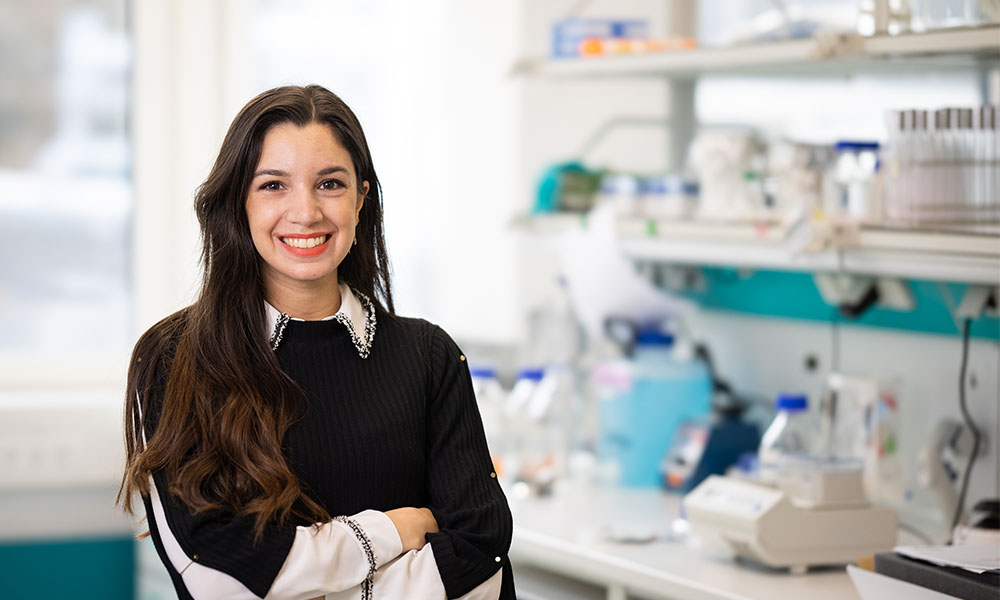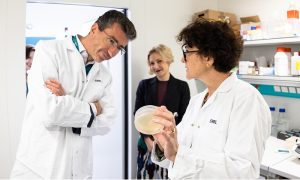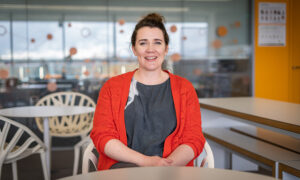
Welcome: Nicoletta Petridou
The new group leader is keen to know how organisms take shape, as well as how Leonardo da Vinci took his coffee

Tell us about your research.
How do we take shape? This is the puzzling question underlying my research. Perhaps it seems a naive question, but if you consider that all of us were once an amorphous mass of cells, it’s mind-blowing to think about how the process of embryogenesis operates, with a precision that is able to shape us into fully functional organisms.
My group focuses on a particular developmental time period, corresponding to the onset of morphogenesis – the process in which a tissue or organism develops its shape. During this time, embryonic cells start acquiring new features, such as the ability to move in a certain direction and change their identity. What’s intriguing is that this process always happens in a very similar way, even though it’s the outcome of interactions taking place in what we call a ‘noisy’ environment – one in which embryonic cells are exposed simultaneously to countless chemical and mechanical signals, which show a certain amount of random variability. To understand how cells decode all these signals to create complex organisms, we use zebrafish embryos and combine methods from embryology, live quantitative imaging, and biophysics with theories from statistical mechanics. Currently, we’re focusing on understanding how the structural properties of tissues are regulated in space and time by the underlying biochemical signals, and what their role is in changing cell identity during morphogenesis.
How will being at EMBL move your research to the next level?
Working at EMBL means being part of an interdisciplinary community. There are facilities that are crucial for my research, such as the Advanced Light Microscopy Facility and the fish biology facility. I’m also eager to start exploring the Proteomics and Metabolomics Core Facilities, as well as expanding more in the fields of adaptive microscopy and quantitative image analysis. I’m looking forward to interacting with a wide range of scientists here.
Even early on, at the University of Cyprus, your fundamental research seemed to inform what we know about genetic disorders and cancers. Will your work continue in that same vein, still adding to the body of knowledge that could advance those areas of medicine?
During my early research career, I focused on research that would inform us about certain aspects of developmental abnormalities and disease. Specifically, I focused on a class of proteins called focal adhesion proteins, and their role in cell movement and embryo development. These proteins are also known to be involved in the progression and spread of cancer. My findings uncovered the protein interactions necessary for embryonic cells to move properly and shape the embryo. But I realised that there’s still so much we don’t know about the link from molecules to embryos. Embryos display a much higher level of complexity and their morphogenesis cannot be explained solely by unravelling protein interactions. So, later in my PhD and for my postdoc, I started focusing on how to bridge scales in morphogenesis. Finding the links between scales gives a more holistic understanding of how a system operates, and only then can we have more targeted medical therapies.
Where and when did you first get interested in science and specifically molecular biology?
I can’t really remember when I first realised that I wanted to be a scientist. I think it’s something that grew within me, and is still growing within me. I can remember being interested in the world around me and in trying to understand it. I can remember being annoyed if I didn’t understand something!
When I was deciding on schools for my bachelor’s studies, I was torn between physics and biology – I assume because both disciplines are about trying to understand our world. In the end, I chose to study how the living world is formed. It’s quite funny, though, that I ended up using statistical physics – which explains how water boils or how an avalanche is formed – to understand life.
If you could chat with three famous people over coffee and cake, who would they be and why?
If I could choose any people in the course of history, my selection would be:
- Leonardo da Vinci. I’d like to know how the universal genius takes his coffee!
- Coco Chanel, because I like her fashion not only for its style, but also because it was a big step towards greater liberation of gender identity.
- Sandra Bullock, so I can practice German with a worldwide celebrity!
I would take them all for coffee and cake in a Viennese coffee shop, perhaps at Café Schwarzenberg, which is in my old neighbourhood.
What excites you most about your research?
That it’s at the interface of different disciplines. I’m amazed by how similar physical principles – like those that explain the formation of patterns in nature, such as the shape of a snowflake – can also explain the formation of patterns in an embryo. Looking at the same process from different viewpoints can give an in-depth understanding of how life is created.
What music are you most likely to play in the lab, and do zebrafish seem to like music?
Whatever music we play in the lab, we should definitely be dancing to it! And our fish should be swimming to it!


